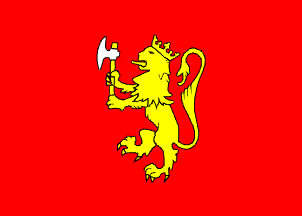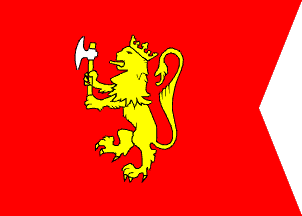 christopher oehler
christopher oehler
Keywords: norway | lion: with axe (yellow) | axe | haakon vii (of norway) | oscar ii (of sweden and norway) |
Links: FOTW homepage | search | disclaimer and copyright | write us | mirrors

Last modified: 2021-08-25 by  christopher oehler
christopher oehler
Keywords: norway | lion: with axe (yellow) | axe | haakon vii (of norway) | oscar ii (of sweden and norway) |
Links: FOTW homepage |
search |
disclaimer and copyright |
write us |
mirrors
Royal Standard

image by Željko Heimer, based on Album 2000 [pay00]
Royal Masthead Pennant

image by Željko Heimer
See also:
Outside Links
A yellow crowned lion rampant holding a white and yellow axe on a red field.
The standard was introduced in 1905 when King Haakon VII became king of Norway.
The lion in the Royal standard is different from the one in the
national coat of arms - where the lion is kept in a more
flat style. The standard of the Crown Prince is the Royal standard with 'an obtuse
swallow-tail'. The proportion of the Royal standard is 5:7.
Jan Oskar Engene, 23 November 1995
The specification for the lion on the Royal standard has never been changed. The 1905 version is still in use. However, the lion on the Norwegian coat of arms changed from the 1905 version in 1937, and the result is two very diverging drawings. In the 1937 coat of arms the lion's paws and claws are almost those of a bird. The whole drawing is strictly flat or 'stylized'. This redrawing was the work of state archivist Hallvard Trætteberg - his ideas about heraldry strongly influenced public heraldry since the early 1930s (see for instance the county flags). There have been minor changes to the lion in the coat of arms - most recently in 1994. So, a picture of the Royal standard with the coat of arms lion is wrong.
The Royal Ministry of Foreign Affairs produced some very attractive brochures on the flag and arms last year - also mainly in Norwegian but with nice pictures. If you want them, the address to contact is:
Royal Ministry of Foreign Affairs
Protokollavdelingen
Postboks 8114 Dep, 0032 Oslo
Phone + 47 22 34 36 00 Fax + 47 22 34 95 80 (No e-mail yet)
You could also try the Norwegian embassy in your country.
Jan Oskar Engene, 24 November 1995
Standard of the Crown Prince
 image by Željko Heimer, based on Album 2000 [pay00]
image by Željko Heimer, based on Album 2000 [pay00]
There are just two flags for the Royal family. One for the King and one for the
Crown Prince (or, because the constitution has now been changed, the Crown Princess).
The flag of the King is a banner of the arms of Norway, though in a more old fashioned
artistic style compared with the official version of the arms of Norway. It was
introduced by Cabinet Decision of 15 November 1905. The flag of the Crown Prince
is the same banner of the arms of Norway except that the field is swallowtailed.
It was introduced by Royal Resolution of 26 December 1924. The flag of the King
is also used by the Queen, and the Crown Prince's flag by the Crown Princess. No
flags for the rest of the royal family.
Jan Oskar Engene, 5 May 1997
The Danish and Swedish Royal flags are much older than the Norwegian royal flag which dates from 1905. When Norway and Sweden was united under the same king, the Royal flag was based on the same pattern: War ensign (Swedish or Norwegian version depending on the country) with union mark in the canton and with the 'union' arms in the white field in the centre of the cross. When Prince Carl of Denmark accepted the offer of the throne of Norway he decided that the Royal flag would be a banner of the arms of Norway. I can only speculate as to the reason for this. One could be a break with the past, that is a break with the established Swedish-Norwegian pattern. A second reason could be that an attempt was made to connect with the golden age of Norwegian history. The arms of Norway, on a field of red a gold crowned lion rampant holding an axe, is known from about 1280, and it is likely that it was used as a banner by the kings of Norway.
King's Standard - 1905 rendering
![[1905 Standard of the King]](../images/n/no-k1905.gif) image
by Jan Oskar Engene
image
by Jan Oskar Engene
When you read accounts of the 1905 events, you can sometimes see the Royal flag described as the 'ancient banner of the kings of Norway', suggesting the rebirth of the nation.
As there was no former Norwegian royal family to offer the throne to, it was initially offered to a prince of the House of Bernadotte, that is a Swedish prince. However, the old king, Oscar II, was so offended by the actions of the Norwegians that he declined the offer (much to the relief of the Norwegians).
When it was clear that the king of Sweden turned down the offer, the offer was given to a grandson of the king of Denmark, Prince Carl. He was married to Princess Maud, daughter of the King of England etc., which was very convenient for the Norwegian government as it wanted a favourable attitude from the British. Prince Carl accepted the offer but insisted on a referendum because he didn't want to become king unless the people wanted him. On announcing his final decision he took the name Haakon VII as king of Norway (his two year old son Alexander was given the name Olav, he became king Olav V).
One interesting fact about the dissolution of the union is that the king, Oscar II, was so offended by the behaviour of the Norwegians that he demanded that the Royal standard from the royal palace in Oslo be sent to him in Stockholm. This flag is still kept in the library at the royal palace in Stockholm.
The Norwegian flag (civil flag/ensign) was originally adopted in 1821 and remained unchanged except for the union mark in the canton. The union mark was introduced in 1844, but removed from the state flag and ensign in 1898 and from the war flag and ensign in 1905. Sweden removed the union mark de facto in 1905 and de jure in 1906.
The arms of Norway remained the same throughout the unions with Denmark and Sweden,
and did not change with the dissolution of the union with Sweden. In 1905, a banner
of the arms was made the Royal flag. Of course, the union arms of Norway and Sweden
lapsed with the dissolution of the union.
Jan Oskar Engene, 24 and 26 April 1998
I spent some time in Norway after the International Congress of Vexillology, so I took chance to take a look at some flag data in a lexicon. According to Aschehoug og Gyldendals: "Store norske leksikon", 3. utgave. the royal standard is introduced in 1905 while the swallow-tailed version for the crown-prince is introduced only in 1924.
Jan Oskar writes that the two are also used by the Queen and Crown-princess
respectively,
but it is not clear to me whether they are used so by the ruling Queen (and direct
descending Crown-princess) or also by the female members of the family that are
married to the ruling members. I don't even know if such distinction (typical for
the British royal family) exists in Norway.
Željko Heimer, 12 August 2003
On the Norwegian Royal Regalia website there are images of two ceremonial Royal Standards, intended for use during coronations.
As a bonus, here are two pictures on how these standards were displayed:
Miles Li, 16 February 2008
The oldest one of these was made for the 1818 coronation that placed the first member of the Bernadotte dynasty on the Norwegian throne. Until this website, and the two books from which it is based (Norwegian/English editions), put out the photo I actually thought this banner had been lost. I have seen it referred in writing before, but never seen it illustrated. So this is a great discovery for me. The 1906 banner, on the other hand, is quite well known in the literature and from photos and illustrations (including patriotic postcards from 1905).
I wonder a bit about the terminology used by the regalia website, and also
by the English version of the book on the matter. To me, royal standard, is
the term for the royal flag, hoisted on ships and on flag poles to indicate
the presence of His Majesty. The two banners in question here, on the other
hand, have a different design and are one-of-a-kind banners set up like a
military colour, that is with the cloth attached to the pole. In Norwegian
the term for these banners are "riksbanner". The term "riks", as noted
before on this list, is notoriously difficult to translate into English. The
choice made by the regalia website tilts associations in a royal direction,
whereas the Norwegian term associates the banner with the kingdom in the
sense "country". Perhaps something like "banner of the realm" would be a
more appropriate term. Some might prefer the term "national banner", but I
am not sure "national" gives the right association here.
Jan Oskar Engene, 16 February 2008
But the two flags in question are not royal standards under the term as it is usually used - these flags do not represent the royality as the royal standards do, the two flags are used for the sole purpose of ceremony during the coronation (well, actually one of the two is obsolete, of course), as Jan Oskar pointed out and there they represent the "realm" (and probably the sovereign's sovereignty over it.
The term proposed by Jan Oskar is more or less exact translation of he original name of these and this may be mentioned together with the Norwegian name on the page discussing them, but of the purpose of the vexillological "classification", I would tend to put these two flags used the term "coronation flags".
The "coronation flags" were used by Hapsburgs on their coronations in Vienna, Prague and Budapest, since at least 16th century (until the last coronation of Karl I. in 1916) where the "realms" (various crown lands) of which the sovereign was being crowned was ruler (see also Austro-Hungarian Landesfarben on FOTW). In this regard, there are several coronation flags preserved in the Croatian History Museum (see Croatia - Historical Flags (Pre-1848)), they are mentioned on our Hungarian pages (Hungarian - Historical Flags - Kingdom of Hungary (pre-1948) (also, I think the replicas of an 1867 set were (and probably still are) on display in Mathias Church in Budapest).
I would guess that some other coronation flags of Hapsburgs would be preserved in museums and churches on the territory of the previous Monarchy.
I would guess that on the territory between the old Dual Monarchy and
Norway a number of coronations would have taken place that would
follow the same basic pattern (ceremonial) and would have employed
such coronation flags, although I do not think that I have head about
them.
Željko Heimer, 16 February 2008
The constitution prohibits the granting of noble titles, but the king may decided the titles of members of the royal family.
According to Article 34 of the Constitution "The King shall make provisions concerning
titles for those who are entitled to succeed to the Crown."
Jan Oskar Engene, 14 August 2002